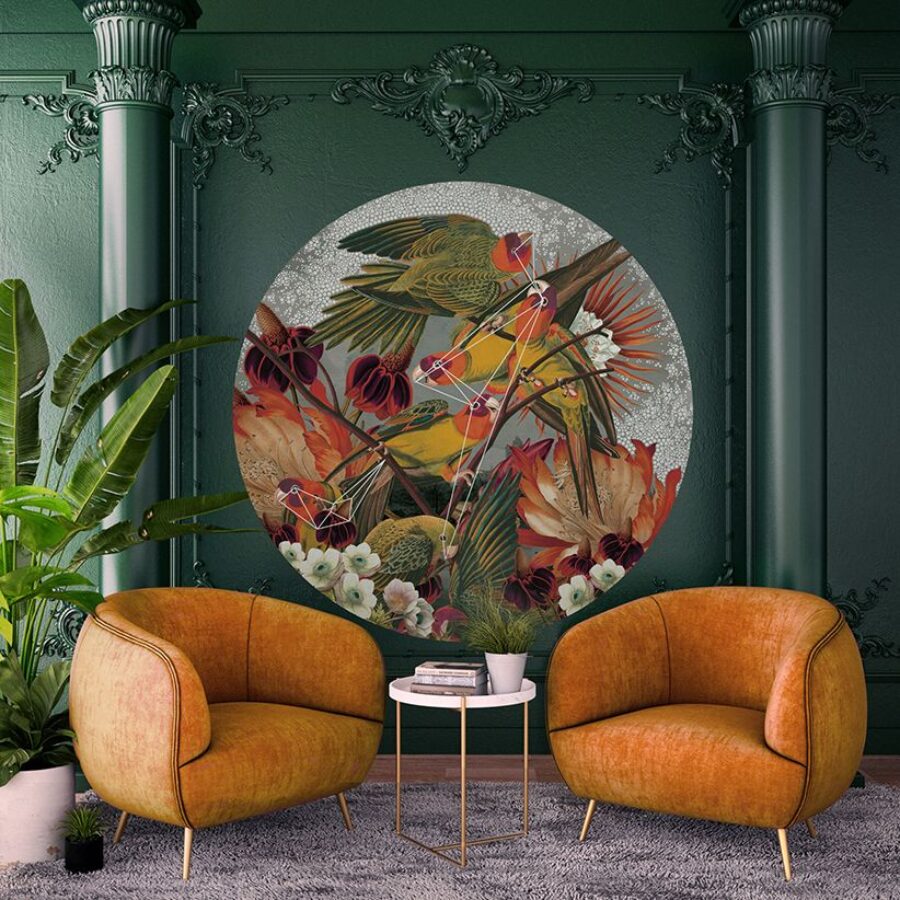Art as an Integral Element in Modern Architecture
The relationship between art and architecture has been fundamental throughout human history, from ancient cave paintings to Gothic cathedrals, where art served functional, narrative, and emotional purposes. This deep connection has historically fostered a rich tapestry of human culture. Ancient Egyptians used hieroglyphs and murals to convey beliefs in temples and tombs, while the Parthenon in Greece showcased seamless integration with mythological narratives carved into its structure. Medieval Gothic cathedrals incorporated intricate carvings and stained glass, providing both decoration and light.
However, the 20th century saw a reduction in art integration with the rise of Modernism, often viewing art as a mere complement rather than an inherent part of architectural concepts. This separation could lead to “sterile and emotionless” spaces. The Bauhaus movement countered this by emphasizing interdisciplinary collaboration, re-strengthening the link between art, design, and architecture. The current resurgence of art integration reflects a return to the fundamental human need for emotional resonance and identity in the built environment, driven by the understanding that a building lacks desirability without these aesthetic and emotional dimensions.
In modern interior design, art is now recognized as an essential architectural element that shapes a space’s character, moving beyond mere decoration. Art enriches structures by conveying cultural narratives, fostering community identity, and creating interactive environments. It transforms buildings into “dynamic, living entities” that inspire and provoke thought, leading to a harmonious user experience when combined with architectural and interior design synergy. The interplay of color, textures, and lighting influences senses and emotions, allowing art to create tactile and emotional dimensions that profoundly affect spatial perception and human behavior. This is especially vital in an increasingly digital world, where physical spaces need unique sensory experiences to maintain their appeal.

Why Interior Designers Collaborate with Artists
Integrating artwork into modern interiors is a strategic response to the demand for spaces that are functional, emotionally resonant, identity-forming, and value-enhancing. Interior designers are increasingly recognizing the unique perspectives and skills artists bring that extend beyond traditional design. Successful projects often stem from close collaboration between architecture and interior design professionals from the outset, ensuring that architectural elements align with the interior designer’s vision. This integration balances aesthetics with functionality, creating environments that resonate with users. For instance, in a hospital, art and architecture can be integrated to aid wayfinding while introducing energy and joy. This deeper integration means art becomes part of the wall’s purpose and the overall functionality of the space.
Art also enhances emotional resonance, functionality, and user experience, serving as a strategic tool to improve mental health, productivity, creativity, and overall well-being. It can influence human experiences and behaviors, define collective identity, and serve as a “humanizing fulcrum” for engagement with the building, aiding placemaking. Beyond direct benefits, art contributes to “soft values” like well-being, inspiration, and emotional connection, which are increasingly crucial for the attractiveness and success of spaces. A space that evokes well-being or inspiration holds greater, albeit harder to quantify, value.
Artists bring invaluable unique perspectives to architectural projects, introducing new ideas and challenging architects to think beyond familiar patterns. Collaboration leads to solutions neither could achieve alone, leveraging the divergent mindsets of architects (structural, functional) and artists (conceptual, emotional) as a source of innovation rather than a hurdle.
Art significantly enhances a property’s identity and value by creating a strong visual focal point and boosting perceived value. High-quality or distinctive art signals luxury, attracting collectors willing to pay more. Art can also be a financial investment, appreciating in value and contributing to portfolio diversification due to its low correlation with financial markets. In the luxury real estate market, art acts as a “liquidity anchor,” attracting specific buyers and accelerating sales by creating a unique identity and emotional connection. This maximizes ROI, transforming art into a powerful market and value-creation tool.

Case Studies and Design Concepts
Leading interior designers demonstrate how original artworks can be seamlessly integrated into modern spaces, creating unique atmospheres and identities, with art forming the heart of their designs.
Kelly Wearstler: The Art of Bold Maximalism Kelly Wearstler is renowned for “bold maximalism,” characterized by vibrant colors, rich textures, and daring combinations. Her multidisciplinary studio emphasizes detail and creative expression, layering materials like metals, marble, velvet, and woods to create depth. Despite this abundance, her spaces achieve a balance between bold statements and subtle sophistication. For Wearstler, art is “essential” and gives a space “soul”. She integrates sculptural furniture with large-format paintings, encouraging clients to see art as integral to the design. Her approach focuses on storytelling, aiming for love and comfort in every space. In the Santa Monica Proper Hotel, she used art in the lobby with curved furniture and Mid-Century pieces to create a “fun statement” and visual interest. Wearstler’s maximalism is a curated method of telling complex stories through art and texture, where artworks are protagonists generating tension and energy. This layering creates dynamic, engaging, and emotionally resonant environments.
Studio Ashby: Authenticity and Eclectic Elegance Studio Ashby is known for creating spaces with unique identities, combining authenticity, timeless elegance, and eclectic style. Founder Sophie Ashby draws inspiration from antiques, contemporary art, craftsmanship, modernist furniture, and global influences. Art is central to her process, as seen in her luxurious residences and commercial spaces worldwide. Her book “Home Art Soul” showcases her art-driven creative process. In a collaboration with COS, Studio Ashby curated works by female artists, synchronizing their size and materiality with the store’s architecture and ambiance. Her ability to mix antiques and contemporary art allows art to mediate between eras and styles, imparting “timeless elegance” and a rich, multifaceted identity. Art functions as a “temporal bridge” in her designs, creating a seamless dialogue between past and present, ensuring spaces feel personal, authentic, relevant, and inspiring.
Joseph Dirand: Minimalist Opulence and Precise Curation Joseph Dirand is recognized for timeless elegance, fusing minimalism with luxurious materials and meticulous detail. His designs feature clean lines, muted palettes, and noble materials like marble, emphasizing light and carefully selected elements. Dirand plans projects with extreme precision, controlling every detail down to the placement of paintings and books. In projects like “Le Jardinier” in New York, curated artworks add sophistication to light-filled, minimalist spaces. Dirand’s “minimalist opulence” is a conscious reduction of the superfluous to highlight art and materials. The space becomes a meticulously designed stage that maximizes the impact of the art without competing with it. By omitting ornamentation and focusing on pure forms, Dirand creates a “visually quiet” backdrop, where art is orchestrated for maximum impact and sophistication, becoming indispensable to the controlled aesthetic.
Vincent Van Duysen: The Poetry of Quiet Minimalism Vincent Van Duysen is known for his quiet minimalism, softening monolithic forms with tactile surfaces and natural materials like wood, stone, and linen. His designs convey calm, emphasizing simplicity, space, and light. He believes architecture should be “visually silent,” creating a harmonious atmosphere. Van Duysen sees light as a “shaping tool” that defines volume and enhances three-dimensionality, with strategic window placement and interior lighting contributing to a dynamic interplay of light and shadow. His residential projects are intimate and warm, tailored to clients’ needs for comfort and timeless elegance. The AN Residence, for example, features sculptural stone cladding that brings the garden indoors. In his own residence, he integrates collected artworks into a muted palette of natural materials. Van Duysen’s minimalism is a conscious reduction that focuses on material quality, light, and human experience. Artworks become “silent” amplifiers of this atmosphere, promoting contemplation and sensory depth rather than overloading the space. The effect is calm, contemplative spaces where art subtly enhances existing tranquility and reinforces the tactile dialogue of materials and light, deepening the desired “meditative stillness”.

Strategies for Integrating Artworks
Choosing the right strategy for art integration is crucial for design success.
Wall Installations, Sculptures, and Large-Format Works Large, striking artworks can serve as visual anchors or focal points, while smaller pieces can form dynamic gallery walls. Artwork size should be proportional to the wall and room. Sculptures add texture, movement, and meaning, especially when crafted from natural materials, transforming a room’s ambiance. The choice of these art forms actively influences spatial perception by creating depth, defining zones, or directing the gaze, effectively transforming art into an architectural element that turns the space into a curated experience.
Site-Specific Art Site-specific art is designed for a particular location and loses meaning if removed. This art form emerged in the 1960s to counteract commercialization, belonging exclusively to its created place. It represents the ultimate integration, eliminating the separation between artwork and environment, creating a unique, non-reproducible experience that emphasizes the value of physical space and a deeper connection to it.
Impact on Spatial Perception, Lighting, and Emotional Effect Well-conceived interior design integrating art can improve mental health, productivity, creativity, and overall well-being. The interaction of elements like color, textures, and lighting influences senses and emotions. Proper placement and lighting, such as spotlights, significantly impact art, adding depth and drama to interiors. Artworks, with targeted lighting, act as conductors of the room’s atmosphere, subtly influencing the perception of size, depth, and even temperature, eliciting precise emotional responses beyond mere aesthetics. Art is a dynamic element that orchestrates the entire sensory and emotional experience for the inhabitant.

Practical Tips for Implementation & Collaboration
Successful art integration requires visionary design, understanding conceptual differences, collaborative processes, legal frameworks, and technological tools.
Art in Architecture vs. Art in Space: Conceptual Differences & Planning Levels “Art in Architecture” (Kunst am Bau) refers to artworks permanently affixed to a new or renovated structure, making an “independent artistic contribution to the building task” and relating directly to the building’s architecture or function. Funding often comes from state and federal programs. This integration level is profound, requiring explicit engagement with the site and its function. Examples include large-format photos in the Bauhaus Archive foyer or murals in public spaces. The goal is to contribute to building culture and foster identification with the building.
“Art in Space” (Kunst im Raum / Public Art / Private Art) is art in any medium created for the general public through a public process, installed in public or private spaces. In interior design, it’s often called “spatial art”. Funding can be public or private. Unlike “Art in Architecture,” it doesn’t necessarily respond to the specific location but enriches the urban environment or interior ambiance, and can be “additive”. “Public Art” aims to foster dialogue, provoke thought, and improve urban life quality, being freely accessible to all. In private contexts, it improves user experience, aesthetics, and functionality.
While distinct in origin and funding, their boundaries blur with the focus on “Site-Specific Art,” where art’s deepest impact comes from being inextricably linked to its context, regardless of public or private initiative. This shared emphasis represents a convergence, showing that impactful art integration goes beyond mere placement, becoming an inseparable part of the environment’s identity and experience.
Collaborations between Architectural Firms & Artists Collaboration between architectural firms and artists is key to integrated designs. Successful collaboration starts with “shared intentions” and open roles. Creative breakthroughs emerge from collaborative processes that develop and implement ideas, incorporating diverse input. Artists should be involved early to make art an integral part of the design. The divergent mindsets of architects (structural, functional) and artists (conceptual, emotional) are a source of innovation, leading to solutions that transcend disciplinary boundaries. When architects cede control and artists accept architectural parameters as a creative challenge, a symbiosis emerges, enabling true co-creation and a “permeation of the architectural concept at a fundamental level”.
Commission contracts are essential for larger works, protecting both artists and clients by defining expectations and accountability. Key elements include project description, payment terms, rights (ownership, reproduction, exhibition), an artwork proposal, and a termination agreement. A detailed timeline with checkpoints ensures alignment. The contract serves as a legal protection and a creative guide, structuring the iterative process, ensuring transparency, clear expectations, and minimizing creative risk.
Project Examples of Integrated Collaboration Successful integrated projects go beyond coexistence; art becomes the soul of the structure, defining its identity, function, and human interaction. This is evident when artists are involved from the conceptualization stage. Examples include I.M. Pei’s Louvre Pyramid, described as “a work of art for an entrance hall”; Frank Gehry’s Guggenheim Museum Bilbao with Richard Serra’s monumental sculptures exploring space and perception; Maya Lin’s Vietnam Veterans Memorial, celebrated for its “deep solemnity”; Herzog & de Meuron’s Laban Dance Centre where Michael Craig-Martin used color as an integral element ; and John Lyall’s Tottenham Hale Station where Bruce McLean was deeply involved in concept development. These cases show that deep, early integration allows art to become an inherent part of the building’s identity and function, transforming it into a total work of art where art is the soul. This profound integration elevates projects beyond functional design, creating culturally and emotionally resonant landmarks, proving art is fundamental to architectural success.
Selection Criteria: Color Schemes, Materiality, Bespoke, Art in Architectural Context Careful selection of artworks is crucial for harmonious integration. Color schemes in artwork should harmonize with the room, with bold pieces contrasting neutral rooms and muted pieces working in colorful ones. Small splashes of color can enhance neutral schemes. Coordination creates a coherent and visually appealing environment. Materiality and textures in art and interior design should be coordinated; glossy paintings suit modern spaces, while textured pieces add richness to minimalist interiors. Natural materials in sculptures add depth and character. Bespoke creation ensures unique customization, with artworks commissioned to achieve optimal integration. The designer can create a space that complements the artwork through wall colors, lighting, materials, and furniture. Art should complement the overall aesthetic, purpose, and atmosphere of the space, telling its story. Selection criteria form a “context compass,” ensuring art enhances existing architecture and interior design, feeling as if it “has always been there”.

Recommendations for Collectors
For collectors, strategic collaboration with experts is highly beneficial for integrating original art. Art consultants are key in sourcing pieces, advising, negotiating purchases, and curating site-specific works that complement the design. They manage planning, acquisition, and installation, including timelines and budgets. Collectors should define their personal style and desired mood, research designers, and be open about expectations. Art can be a starting point for the room’s color palette and style. The collector becomes an active “co-creator,” transforming their vision into an integrated, professionally executed spatial identity that reflects aesthetic preferences and investment goals. This allows collectors to design their home decor around art, making the space a personalized gallery reflecting their identity and values, while potentially increasing in value.
Legal & Practical Aspects: Hanging Systems, Insurance, Conservation Conditions Practical implementation requires careful planning of legal and conservation aspects. Flexible hanging systems like wall and ceiling rails, or French cleat systems, allow for easy adjustment and damage-free changing of artworks, ensuring presentation aesthetics and flexibility for future curations. Specialized art insurance offers comprehensive protection for valuable collections, with individualized coverage, liberal appraisal requirements, and access to experts for loss prevention and conservation. This protects investments, allowing confident integration of high-value pieces. Adhering to strict conservation conditions is crucial for preserving artwork value, including maintaining a stable environment (15-25 °C, 45-55% RH), avoiding direct sunlight with UV-filtering glass, and using LED lighting. Proper handling and storage are also essential. Adherence to these conditions is an investment in the artwork’s “lifecycle economics,” protecting its aesthetic condition and long-term value as an asset.
Digital Tools & Visualization Software for Art Integration Modern digital tools revolutionize the planning and visualization of art integrations. ArtPlacer offers customizable room mockups, 3D virtual exhibitions, and an AR mobile app for visualizing art in real scale, saving time and costs while reducing errors. Morpholio Board creates mood boards and material boards, integrating Pinterest accounts and offering AI background removal, simplifying design processes and generating presentations. SketchUp, with add-ons like V-Ray and Enscape, allows importing 2D images and 3D models for photorealistic visualizations, with tools like Veras using AI for rapid design iterations. These digital tools act as “empathy bridges,” enabling clients to realistically imagine art integration, facilitating decision-making, reducing misunderstandings, and creating a deeper emotional connection to the design before physical implementation.

Art as a Full-Fledged Component of Space Identity
Artworks in modern spaces have evolved beyond mere decoration, becoming integral components of space identity, profoundly connecting aesthetics, functionality, and emotional resonance. Art is a “humanizing fulcrum” that transforms spaces into vibrant, breathing environments, influencing spatial perception, lighting, and emotional impact to create a deeper connection between people and space. Integrating art strengthens space identity and property value by signaling luxury, adding a personal touch, and serving as a potential investment. This understanding shifts art’s perception from an isolated object to a central part of a complex spatial ecosystem, where all elements are interconnected. The future of architecture involves artists as well as architects, with sustainability and eco-conscious design influencing the fusion of art and architecture, integrating sustainable energy solutions and materials. Digital tools will continue to revolutionize visualization and implementation. The trend is guided by an “ethics of integration” that considers aesthetic, economic, social, and ecological dimensions, pointing to a responsibility to create conscious and future-proof spaces.









